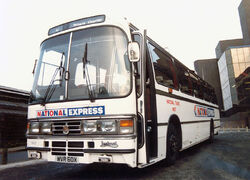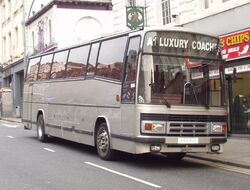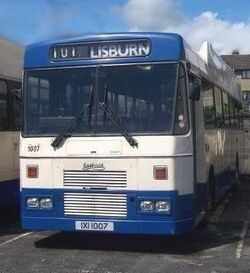| Leyland Tiger | |
|---|---|
 Leyland Tiger with Duple Dominant body | |
| Manufacturer | Leyland |
| Replaced | Leyland Leopard |
| Specifications | |
| Floor type | Step entrance |
| Doors | 1 door |
| Engine(s) | Leyland TL11/Cummins L10/Gardner |
| Transmission | Leyland/ZF/Voith |
| Options | Various customer options |

Leyland Tiger with Plaxton Paramount body
The Leyland Tiger, also known as the B43[1], was a mid-engined bus and coach chassis which was built between 1981 and 1993.[2] This name had previously been used for a front-engined bus built between 1920s and 1950s.[3] It replaced the Leyland Leopard, which had been in production for over 20 years.[4] Leyland's then-competitor Volvo, having already won over many independent customers from Leyland with its successful B58, was at the time developing the B10M[4], which was set to further strengthen its position in the coach industry.
Engine options[]
Initially only one engine was offered, the turbocharged Leyland TL11, which could be rated up to 245 hp. The Leopard had enjoyed huge success as a bus in Scotland, usually with the Alexander Y-type body, but had lost some Scottish Bus Group orders to Seddon's Pennine VII, owing to Leyland's unwillingness to offer a Gardner engine in the Leopard. When Leyland launched the Tiger, it continued this same unwillingness, just as Dennis was developing the Gardner-engined Dennis Dorchester, which similarly had the potential to win SBG orders away from the Tiger. Faced with this possibility, Leyland offered Gardner 6HLX-series engines in the Tiger from 1984. To facilitate this, the Tiger chassis had to be modified, as the Gardner engine was significantly larger than the TL11. Although the threat from the Dorchester was successfully warded off, there proved to be a limited market for the Gardner-engined Tiger outside of SBG.
A North American engine, the Cummins L10, was also made an option by 1987. (Cummins' previous attempt to put its engines in a British bus had not been a success; they were used in the notoriously unreliable Daimler Roadliner). Engine design and development was very expensive, and Leyland was no longer a world leader in this field, so outsourcing was the only option if Leyland wanted modern engines in its coaches. The Cummins engine was being specified more often from around 1988, and with this engine, the gearbox would usually be a ZF as opposed to the Leyland Hydracyclic.
Volvo took over Leyland in 1988, and from 1989 the Tiger was offered with the Volvo THD100-series engine (as fitted in the best-selling B10M). The large majority of Volvo-engined Tigers went to Northern Ireland. At around this time, the TL11 and Gardner options were dropped, leaving only the Cummins and Volvo options available.[5]
Bus version[]

Ulsterbus Leyland Tiger Alexander (Belfast) N-Type 1007 (IXI 1007). This bus followed the example of many other Tigers and was sold for scrap on 06/07/08

The last Leyland Tiger. Ulsterbus Alexander (Belfast) Q-Type 1500 (YXI 5500)
Like the Leopard, the Tiger was also sold as a bus. Usually it would have a downrated engine, and leaf springs in place of the standard air suspension. The Scottish Bus Group bought batches of these usually with Alexander TS-type bodywork and Gardner 6HLXCT engines. Small independent operators also took an interest in the Tiger as a bus. Bodywork for the Tiger bus was built by Alexander (the T-type and P-type), Plaxton (Bustler and Derwent), East Lancs (some of which were rebodies), Wadham Stringer and Reeve Burgess (who built an unusual batch of short Tigers for Tayside).
The Tiger also proved to be very popular in Northern Ireland, with Ulsterbus and Citybus (known as Metro since February 2005) purchasing 747 between 1983 and 1993. Approximately 157 are still in service as of January 2010, compared to 576 in 2007. 7 are N-Types (with seven others being used as towbuses) and 150 are Q-Types including 10 bodied Wright Endeavour. The number of N-Type Tigers left with Ulsterbus and Citybus have decreased significantly in the past few years, as fleet numbers 340-499, 1000-1339, and Gardner-engined 2601-2635 have been withdrawn.[6] All in an attempt to 'modernise' the Ulsterbus and Citybus (Metro) fleet. As of January 2010, only the Volvo engined Tigers remain in active service as all Gardner and Leyland engined Tigers have been withdrawn. However, apart from being scrapped, many of these vehicles have been sold on to other operators and preservationists. The first Tiger bus to arrive in Northern Ireland was registered DXI 3340 (fleet number 340), new in January 1984 with Ulsterbus (six Tiger coaches were already in the fleet). A body for this type of bus was built in Mallusk, Northern Ireland by Alexander (Belfast), known as the N-Type. Initially, Ulsterbus used the TL11 engine, whilst Citybus used the Gardner TRB6LXB engine on its 1988-89 batches of Tigers with LXI and NXI registrations. The N-Type body ceased production in September 1990, with the last one arriving in Northern Ireland registered RXI 3339 (fleet number 1339. This historical bus was subsequently withdrawn and sold for scrap in April 2007.) It was then replaced by the Q-Type body, which was built on Tigers 1321, 1340-1500 and 2636-2680 up until August 1993 (and thereafter on its successor the Volvo B10M for a further two years). These later Ulsterbus Tigers (fleet numbered 1300-1500) and Citybus Tigers (2636-2680) were fully automatic and were equipped with a Volvo engine. The first of the Q-Types, which was a prototype, also came to Northern Ireland, registered RXI 3321 (fleet number 1321) in December 1990. The very last Tiger to enter service did so in Northern Ireland, this being registered YXI 5500 (fleet number 1500) in August 1993.
The Tiger was very popular in Australia as well, with many units entering NSW fleets. The biggest customer for the Tiger in Australia was arguably Ventura in Melbourne who purchased around 70 Tigers over a four year period. All but one of these units carry a Pressed Metal Corporation body built in Sydney, but there is one with a PMC Adelaide body built in South Australia which was purchased second hand. These Tigers began to arrive at Ventura in April 1984 and the last batch was delivered in October/November 1987 but did not get registered or enter service until early 1988. These buses are now withdrawn from service from Ventura, with a small number living on for school bus duties only.
Many Tigers are in operation by the NSW bus company, Premier Illawarra who possesses around 30-40 of these vehicles in relatively good condition for their age.
Volvo ownership[]
- Main article: Leyland Bus
The Leyland Bus division was bought by an MBO lead by manager Ian McKinnon in January 1987, and it looked like the Tiger would continue as before. Just over 12 months later Volvo purchased the business, bringing Britain's two best-selling coaches, the Volvo B10M and Leyland Tiger, under common ownership. Volvo was aware that Leyland had a loyal following, and that the Tiger had a good reputation, and so the Tiger continued. In 1989, despite slow sales, it reassured Tiger loyalists that the chassis was there to stay, positioning it to compete with the Dennis Javelin. But sales remained slow, and in 1990, in an attempt to shift stock, Volvo had Plaxton body forty chassis. Twenty-five of these bodies were fitted with the only Plaxton 321 bodies built, this being the Plaxton derivative of the Duple 320 body acquired when Duple closed.
Volvo acknowledged that the Tiger and B10M were broadly similar, and whereas Leyland had sold 3,500 Tigers since the model's launch, Volvo had sold 20,000 B10Ms during the same period. The penultimate major buyer of the Tiger, was tout operator Shearings, who switched to the B10M for 1991, and Volvo finally decided to cease production on the same date as the factory that built it, in Workington, closed.
Preservation[]
Add details of any known examples of the Leyland Tiger that are in Preservation in museums or with private collectors.
Template:PML Leyland Tiger
See also[]
- List of Bus Manufacturers
- Coachbuilder
- Museums List
References / sources[]
- ↑ Made in Prston home page
- ↑ Bus Lists on the Web
- ↑ London TD class Leyland Tiger buses
- ↑ 4.0 4.1 Jack, Doug (1994). Beyond Reality. Venture Publications, 90. ISBN 1898432023.
- ↑ Irish Transport Trust
- ↑ Ulsterbus & Citybus Leyland Tiger
External links[]
| ||||||||||||||
| ||||||||||||||||||||
| This page uses some content from Wikipedia. The original article was at Leyland Tiger. The list of authors can be seen in the page history. As with Tractor & Construction Plant Wiki, the text of Wikipedia is available under the Creative Commons by Attribution License and/or GNU Free Documentation License. Please check page history for when the original article was copied to Wikia |